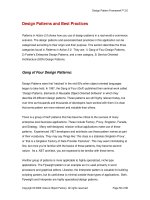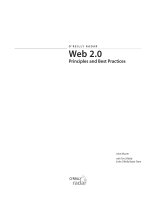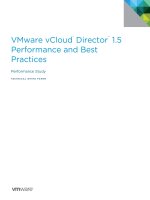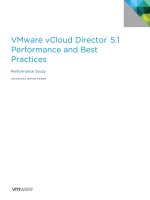customer service delivery research and best practices
Bạn đang xem bản rút gọn của tài liệu. Xem và tải ngay bản đầy đủ của tài liệu tại đây (969.96 KB, 347 trang )
Customer
Service Delivery
Research and
Best Practices
Lawrence Fogli, Editor
Foreword by Eduardo SalasCustomer Service Delivery
THE PROFESSIONAL PRACTICE SERIES
The Professional Practice Series is sponsored by the Society for In-
dustrial and Organizational Psychology (SIOP). The series was
launched in 1988 to provide industrial/organizational psycholo-
gists, organizational scientists and practitioners, human resource
professionals, managers, executives, and those interested in orga-
nizational behavior and performance with volumes that are in-
sightful, current, informative, and relevant to organizational
practice. The volumes in the Professional Practice Series are
guided by five tenets designed to enhance future organizational
practice:
1. Focus on practice, but grounded in science
2. Translate organizational science into practice by generating
guidelines, principles, and lessons learned that can shape
and guide practice
3. Showcase the application of industrial/organizational
psychology to solve problems
4. Document and demonstrate best industrial and
organizational-based practices
5. Stimulate research needed to guide future organizational
practice
The volumes seek to inform those interested in practice with guid-
ance, insights, and advice on how to apply the concepts, findings,
methods, and tools derived from industrial/organizational psy-
chology to solve human-related organizational problems.
Previous Professional Practice Series volumes include:
Published by Jossey-Bass
Improving Learning Transfer in Organizations
Elwood F. Holton III, Timothy T. Baldwin, Editors
Resizing the Organization
Kenneth P. De Meuse, Mitchell Lee Marks, Editors
Implementing Organizational Interventions
Jerry W. Hedge, Elaine D. Pulakos, Editors
Organization Development
Janine Waclawski, Allan H. Church, Editors
Creating, Implementing, and Managing Effective Training
and Development
Kurt Kraiger, Editor
The 2lst Century Executive
Rob Silzer, Editor
Managing Selection in Changing Organizations
Jerard F. Kehoe, Editor
Evolving Practices in Human Resource Management
Allen I. Kraut, Abraham K. Korman, Editors
Individual Psychological Assessment
Richard Jeanneret, Rob Silzer, Editors
Performance Appraisal
James W. Smither, Editor
Organizational Surveys
Allen I. Kraut, Editor
Employees, Careers, and Job Creation
Manuel London, Editor
Employment Discrimination Litigation
Frank J. Landy, Editor
The Brave New World of eHR
Hal G. Gueutal, Dianna L. Stone, Editors
Published by Guilford Press
Diagnosis for Organizational Change
Ann Howard and Associates
Human Dilemmas in Work Organizations
Abraham K. Korman and Associates
Diversity in the Workplace
Susan E. Jackson and Associates
Working with Organizations and Their People
Douglas W. Bray and Associates
Service Delivery
Research and
Best Practices
Lawrence Fogli, Editor
Foreword by Eduardo Salas
Copyright © 2006 by John Wiley & Sons, Inc. All rights reserved.
Published by Jossey-Bass
A Wiley Imprint
989 Market Street, San Francisco, CA 94103 www.josseybass.com
No part of this publication may be reproduced, stored in a retrieval system, or transmitted
in any form or by any means, electronic, mechanical, photocopying, recording, scanning,
or otherwise, except as permitted under Section 107 or 108 of the 1976 United States
Copyright Act, without either the prior written permission of the publisher, or authorization
through payment of the appropriate per-copy fee to the Copyright Clearance Center,
Inc., 222 Rosewood Drive, Danvers, MA 01923, (978) 750-8400, fax (978) 646-8600, or
on the Web at . Requests to the publisher for permission
should be addressed to the Permissions Department, John Wiley & Sons, Inc.,
111 River Street, Hoboken, NJ 07030, (201) 748-6011, fax (201) 748-6008, or online
at />Limit of Liability/Disclaimer of Warranty: While the publisher and author have used
their best efforts in preparing this book, they make no representations or warranties with
respect to the accuracy or completeness of the contents of this book and specifically
disclaim any implied warranties of merchantability or fitness for a particular purpose. No
warranty may be created or extended by sales representatives or written sales materials.
The advice and strategies contained herein may not be suitable for your situation. You
should consult with a professional where appropriate. Neither the publisher nor author
shall be liable for any loss of profit or any other commercial damages, including but not
limited to special, incidental, consequential, or other damages.
Readers should be aware that Internet Web sites offered as citations and/or sources for
further information may have changed or disappeared between the time this was written
and when it is read.
Jossey-Bass books and products are available through most bookstores. To contact
Jossey-Bass directly call our Customer Care Department within the United States at
(800) 956-7739, outside the United States at (317) 572-3986, or by fax at (317) 572-4002.
Jossey-Bass also publishes its books in a variety of electronic formats. Some content that
appears in print may not be available in electronic books.
Library of Congress Cataloging-in-Publication Data
Customer service delivery : research and best practices / Lawrence Fogli, editor.— 1st
ed.
p. cm. — (The Society for Industrial and Organizational Psychology Professional
Practice series)
Includes bibliographical references and index.
ISBN-13: 978-0-7879-7620-0 (alk. paper)
ISBN-10: 0-7879-7620-2 (alk. paper)
1. Customer services. 2. Customer relations—Management. I. Fogli, Lawrence. II.
Professional practice series
HF5415.5.C839 2006
658.8'12—dc22
2005021210
Printed in the United States of America
FIRST EDITION
HB Printing 10987654321
The Professional Practice Series
SERIES EDITOR
Eduardo Salas
University of Central Florida
EDITORIAL BOARD
Timothy T. Baldwin
Indiana University, Bloomington
Wayne F. Cascio
University of Colorado
Kenneth P. De Meuse
University of Wisconsin–Eau Claire
Jerry W. Hedge
Personnel Decisions Research Institute, Inc.
A. Catherine Higgs
Allstate Insurance Company
Kenneth Pearlman
Lucent Technologies
James W. Smither
LaSalle University
Scott I. Tannenbaum
State University of New York, Albany
Foreword xiii
Eduardo Salas
Preface xv
Lawrence Fogli
Acknowledgments xix
The Authors xxi
Part One: What Is Customer Service? 1
1 Customer Service from the Customer’s Perspective 3
Stephanie D. Kendall
2 Organizing for Customer Service 22
Robert J. Vance
3 Using Employee and Customer Perspectives
to Improve Organizational Performance 52
Scott M. Brooks, Jack W. Wiley, Emily L. Hause
4 Brands, Expectations, and Experience 83
Clifton Lemon
Part Two: Employees and Customer Service 133
5 Customer Service Quality: Selecting
Valued Performers 135
Jerard F. Kehoe, David N. Dickter
6 Staffing and Selection Strategies for Service Quality 173
Deborah L. Whetzel, Michael A. McDaniel
xi
xii CONTENTS
Part Three: Organizational Change
Management for Service Quality 195
7 Service Encounter Dynamics: Strategies and
Tips for Better Customer Service 197
Diane Catanzaro, Eduardo Salas
8 “This Call May Be Monitored”: Performance
Management for Service Quality 225
Seymour Adler, Miriam T. Nelson
9 What We Need to Know to Develop Strategies
and Tactics to Improve Service Delivery 264
Lawrence Fogli
Name Index 303
Subject Index 309
Foreword
Good customer service—service that is focused on us, the
customers—is all we really want when we buy our groceries, when
we fly, when we go to the hospital, when we eat at a restaurant. We
expect to be treated as valuable customers by everyone who sells
us something—from our accountants to our waste management
employees, our veterinarians to our bank tellers. In reality, the ser-
vice we receive can exceed every expectation or find us feeling dis-
appointed, dissatisfied, or worse. Some companies, agencies, and
organizations excel at providing customer service; others do not.
Some make it part of their culture, a core corporate value, a norm.
Others don’t seem to recognize its value. This book seeks to un-
derstand customer service on many levels: what it takes to create a
corporate culture that nurtures it, how it gives businesses an edge
in the marketplace, and how to select and hire individuals who are
ready, willing, and able to provide it to customers. Customer Service
Delivery: Research and Best Practices is a practical walkthrough in the
customer service arena. A very welcome book—on a topic not
much studied by our profession—but which offers solutions that
are based on recent research.
Larry Fogli and associates have tackled a challenging, unique,
not-oft-discussed topic in the I-O community, yet one that affects
us all every day. These chapters are full of advice, tips, hints, and
strategies that can be applied to improve customer service. We
hope this information is useful to anyone seeking to learn more
about customer service from different perspectives. We know that
exemplar customer service matters in organizational performance,
so this volume should matter to those who create and manage or-
ganizations that rely on customer service to remain competitive.
On behalf of the SIOP Professional Practice Series Editorial Board,
xiii
xiv FOREWORD
I would like to thank Larry and the authors for giving us such a
practical and timely gem.
University of Central Florida E
DUARDO SALAS
October 2005 Editor
Preface
Over the past two decades, customer service delivery has become
a catchphrase for businesses, as well as an inescapable part of mod-
ern life. Not a day goes by without multiple opportunities to en-
gage in service transactions at grocery stores, banks, restaurants,
and a host of other businesses. The service sector has become the
largest part of the U.S. economy. The explosive growth of the U.S.
service sector, coupled with every company’s need to compete for
market share, has resulted in an increased emphasis on improving
customer service delivery as a boon to organizational survival. Busi-
ness, marketing, and psychological research and practices provide
a wealth of knowledge about customer service. Individuals engaged
in the application of I/O psychology principles and practices have
been involved in assisting organizations to both define the vision
and implement the strategies.
The purpose of this book is to integrate our research and prac-
tices to provide for common understanding and sharing of our
knowledge for best practices in customer service delivery. We will
provide a framework for customer service as a process and an out-
come. The book is divided into three parts: Part One, “What Is Cus-
tomer Service?” provides definitions and explains customer service
as a process and as an outcome. Topics addressed are customer ex-
pectations, loyalty, satisfaction and dissatisfaction, products versus
service delivery, tangible versus intangible service, measurement,
brand equity, job and industry differences, regional and cultural
differences, and organizational impact.
Stephanie Kendall (Chapter One) points out that services dif-
fer from products in that services are intangible, occur simultane-
ously, and involve customer participation. Poor customer service
can lead to customer switching, but, she explains, customers do
not have to receive the best quality of service to be satisfied because
xv
xvi PREFACE
of their “zone of tolerance.” Because companies are expanding
across the globe, they must be aware that customer satisfaction can
be driven by different factors in different countries, as Kendall elu-
cidates. Robert Vance (Chapter Two) reviews how companies are
using technology to improve and implement customer service
through the Internet and customer relationship management soft-
ware. He discusses recent workforce and organizational changes
that drive the use of technology to service both internal and ex-
ternal customers. Service worker performance is categorized as
prescribed, voluntary, and proscribed. Scott Brooks, Jack Wiley, and
Emily Hause (Chapter Three) review the service-profit chain, bal-
anced scorecard, and linkage research to provide a better under-
standing of the relationships of employee satisfaction, customer
satisfaction, and organizational performance. They conclude that
happy customers are not often loyal customers and that an em-
ployee’s opinion about the climate for service is a good indicator of
organizational performance. Finally, Clifton Lemon (Chapter Four)
asserts that customer satisfaction is declining because employee-
customer contact is being engineered out, and he describes other
negative consequences of technology-driven service systems, like
loss of privacy and spam. Lemon reviews how brands and service
coevolve and how brand equity and service expectations are re-
lated. He notes that service delivery will become more complex as
more products are introduced, technology delivery systems de-
velop, and market segments expand worldwide.
Part Two, “Employees and Customer Service,” is devoted to HR
staffing practices and service delivery. Jerry Kehoe and David Dick-
ter (Chapter Five) discuss task requirements of service jobs, per-
formance expectations, service competencies, specific knowledge
skills, abilities, and other characteristics needed to perform service
jobs. They provide a selection strategy for hiring service workers,
considering job requirements, employee characteristics, and busi-
ness constraints and priorities. Deborah Whetzel and Michael
McDaniel (Chapter Six) review the personality correlates of service
performance, including service orientation, sales drive, cognitive
ability, and vocational interests. They also provide a comprehen-
sive review of assessment instruments that predict customer service
performance.
Part Three, “Organizational Change Management for Service
Quality,” includes strategies and tactics to improve and manage ser-
vice delivery and provides case examples of how organizations have
successfully improved and managed customer service. Diane Catan-
zaro and Eduardo Salas (Chapter Seven) describe the aspects of
service encounters between employees and customers that lead to
customer service improvement. They suggest strategies for im-
proving such encounters, including improving company policies,
educating customers about expectations, training employees, and
improving the quality of services. Seymour Adler and Miriam Nel-
son (Chapter Eight) provide a performance management system
for improving and managing customer service delivery in a call
center. They describe the components of the system, including de-
velopment and implementation of the service model, measure-
ment, performance evaluation, and reporting. In the concluding
chapter (Chapter Nine), I integrate our shared knowledge and de-
scribe organizational strategies and tactics to improve customer
service delivery in an era of unprecedented organizational change.
Pleasant Hill, California L
AWRENCE FOGLI
October 2005
PREFACE xvii
This book would not have been possible without the skill, ability,
and diligence of my editorial assistant, Jennifer Ukei. From its in-
ception to final proofs, Jennifer has done the hardest work to meet
schedules, make necessary edits, and meet publisher formats and
requirements. She was the key contact for all authors and facili-
tated getting all of us to meet deadlines. We are indebted to her
for her unwavering persistence in completing this book.
I want personally to thank all the authors for their commitment
and responsiveness to deadlines and editorial changes. The qual-
ity of the book chapters is evident.
A special acknowledgment goes to Wayne Cascio of the Profes-
sional Practice Series Board and Eduardo Salas, both of whom sup-
ported and motivated me to pursue the publication of this book.
To the reader, my goal was to share our knowledge of customer
service delivery as a resource for our practice. Our challenge is that
customer expectations in service delivery are more demanding
than ever before, and my hope is that the readers of this book will
use it to meet the challenge.
L.F.
xix
Seymour Adler is a graduate of the doctoral program in industrial
and organizational psychology at New York University. He is senior
vice president for talent solutions consulting at Aon Consulting,
where he directs the development and implementation of assess-
ment, performance management, and development programs,
with particular emphasis on customer service, sales, and manage-
ment positions. In addition to a thirty-year career in industry, he
has been on the faculties of graduate I/O programs at Tel Aviv
University, Purdue University, and the Stevens Institute of Tech-
nology, and he is currently an adjunct at New York University. He
is a fellow of the Society for Industrial and Organizational Psy-
chology and served as president of the Metropolitan New York As-
sociation of Applied Psychology.
Scott M. Brooks is general manager of the West Coast region for
Gantz Wiley Research, a consulting firm that helps clients drive
business performance through the strategic use of employee and
customer input. In addition to survey consulting, he has had spe-
cial oversight of the firm’s projects linking employee surveys to cus-
tomer satisfaction and business performance measures. Much of
Brooks’s consulting and research work focuses on leveraging these
links in creating human resource metrics, balanced scorecard
tools, and other frameworks to help clients make better use of
strategic input from employees and customers. Brooks has over fif-
teen years of experience in survey research in numerous industries,
including retail, health care, and service industries. Previously,
Brooks worked in organizational development for Mervyn’s. He
holds a doctorate in industrial and organizational psychology from
Ohio State University and is the author of numerous presentations
and publications on employee measurement topics.
xxi
xxii THE AUTHORS
Diane Catanzaro is an associate professor of psychology at Christo-
pher Newport University in Virginia and teaches undergraduate
and graduate courses in industrial and organizational psychology.
She has consulted on service quality and service encounter–related
issues in a variety of settings, including the health care industry and
law enforcement agencies. Her research and practice have included
service encounter training and service climate–related interventions
in nursing homes, examination of service quality measurement
issues, and assessing adoption and implementation of human re-
source management best practices. Catanzaro has a Ph.D. in in-
dustrial and organizational psychology from Old Dominion
University and an M.A. in industrial and organizational psychology
from Fairleigh Dickinson University.
David N. Dickter is an industrial-organizational psychologist with
Psychological Services. He has held personnel selection manage-
ment roles at AT&T and Aon Human Capital Services, including
the development and implementation of selection tools and sys-
tems for customer service and sales jobs. He is author or coauthor
of several articles, book chapters, and conference presentations.
He is a member of the American Psychological Association, the So-
ciety for Industrial and Organizational Psychology, the Society for
Human Resource Management, and the Personnel Testing Coun-
cil of Southern California. He earned his Ph.D. in industrial and
organizational psychology from Ohio State University.
Lawrence Fogli received his Ph.D. from the University of California,
Berkeley, in organizational behavior and business administration.
A former corporate executive, vice president of human resource ac-
tivities, and external consultant, Fogli has had substantial experi-
ence in the financial, retail, pharmaceutical, manufacturing,
professional sports, entertainment, and insurance industries. His
expertise has been applied to several major companies and indus-
tries in design and implementation of management and talent
staffing systems to improve both individual and company effec-
tiveness. Fogli has expertise in both strategic and specific func-
tional human resource areas such as organizational restructuring,
job design and redesign, improving customer service delivery, ex-
ecutive coaching, individual executive assessment, employee hir-
ing and promotion systems, employee and customer surveys, and
performance assessment feedback. He is the creator of ServiceFirst,
a test designed to hire service-oriented employees, and the devel-
oper of the Sales and Service Excellence System. He also coined
the term total service delivery. Fogli has been published in profes-
sional journals and books on a variety of topics and is a member of
the American Psychological Association, the Society for Industrial
and Organizational Psychology, and the Division of Consumer Psy-
chology. He has taught courses in human resource management
and organizational behavior at the University of California, Berke-
ley; California State University-Hayward, and San Francisco State
University.
Emily L. Hause is an assistant professor of psychology at Augsburg
College. In addition, she has been appointed to various college
posts dealing with service quality, including assessment director,
responsible for North Central accreditation activities, and mem-
bership on the Quality Improvement Steering Committee. Hause
has consulted with a variety of organizations on managerial assess-
ment, performance appraisal design, and synchronous work group
effectiveness. Her publications and presentations have focused on
decision making and job attitudes. She received her Ph.D. in in-
dustrial and organizational psychology from Ohio State University
and is a member of the Society for Industrial and Organizational
Psychology and the American Psychological Society.
Jerard F. Kehoe received his Ph.D. in quantitative psychology from
the University of Southern California. In 1982, he joined AT&T,
where he was responsible for various selection programs including
manufacturing, customer service, sales, and management jobs. In
1996, he assumed overall leadership and direction of AT&T’s se-
lection program. He founded Selection and Assessment Consult-
ing in 2003. Kehoe has written several publications and conference
presentations on employment selection topics, including comput-
erized testing, fairness, and test validity. In 2000, he edited the So-
ciety for Industrial and Organization Psychology’s Professional
Practice Series volume Managing Selection in Changing Organizations:
Human Resource Strategies. He also has served on numerous profes-
sional committees, including the SIOP subcommittee that revised
THE AUTHORS xxiii









